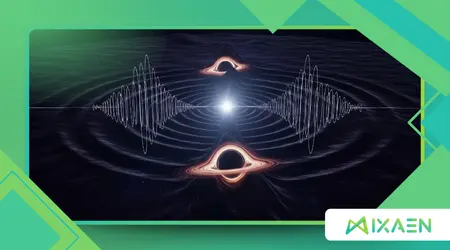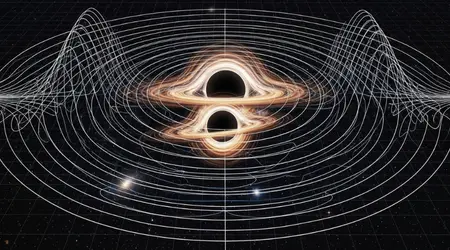Are Gravitational Waves Trying to Tell Us Something We Don’t Understand Yet?

Are Gravitational Waves Trying to Tell Us Something fundamental about the cosmos that current physics models simply cannot account for?
Anúncios
Ten years after the groundbreaking 2015 detection, the universe is now speaking to us in seismic spacetime ripples, not just light.
These profound signals, like the recent, clearest-ever event GW250114 in January 2025, offer an unprecedented lens into extreme cosmic events. The sheer volume and oddity of new data compel us to question our deepest assumptions.
The detection success by the LIGO-Virgo-KAGRA (LVK) collaboration has transformed astrophysics from an observational science into a listening one.
We are rapidly building a new catalog of cataclysmic events: black hole mergers, neutron star collisions, and mixed binaries.
Anúncios
This “listening” approach unveils dark objects and processes previously invisible to electromagnetic telescopes. However, the signals are not always behaving as elegantly as predicted by Einstein’s General Relativity.
The cosmos is much messier than theory suggested, presenting us with unexpected masses and strange signal patterns.
Are Gravitational Waves Trying to Tell Us Something about exotic physics beyond our established Standard Model?
The low-frequency ‘hum’ detected by Pulsar Timing Arrays (PTAs) points toward supermassive black hole binaries. Yet, some individual high-frequency events challenge our stellar formation knowledge.
We are now in an era of gravitational wave anomaly hunting, actively searching for deviations from expected waveforms.
Each new detection is a rigorous test of Einstein’s century-old theory in extreme gravity environments. The most perplexing signals might be the most valuable, hinting at entirely new astrophysical phenomena.
What Anomalous Signals Are Challenging Current Black Hole Theory?
The most compelling mysteries reside in the masses of the merging black holes we now regularly observe.
Stellar evolution theory neatly predicts a maximum black hole mass, approximately $65 M_{\odot}$, before a star explodes entirely. This is known as the “pair-instability mass gap.”
The signal Are Gravitational Waves Trying to Tell Us Something particularly strange about formation channels.
The merger event GW190521, detected in 2019, featured progenitor black holes weighing roughly $85 M_{\odot}$ and $66 M_{\odot}$. One or both of these masses firmly sits within that predicted mass gap.
How did a black hole of $85 M_{\odot}$ form if stellar death should prevent it? Current theories suggest hierarchical mergers, where a black hole forms from previous smaller mergers.
This process likely occurs in dense environments like active galactic nuclei or globular star clusters. This single, powerful event essentially forced astrophysicists to redraw the theoretical boundaries of stellar collapse.
The LVK team detected over 300 candidates in the past decade, yet events like GW190521 remain the most significant challenges. We must now refine our understanding of supernova physics and stellar nurseries.
++ Why the Expansion of the Universe Is Accelerating Without Clear Cause
How Does the Low-Frequency ‘Hum’ Point to Uncharted Territory?
Ground-based detectors like LIGO observe high-frequency waves, but a network of radio telescopes monitors the extremely low-frequency signals.
These are the Pulsar Timing Arrays (PTAs), like NANOGrav and the EPTA. PTAs look for tiny timing deviations in radio pulses from millisecond pulsars across the galaxy.
In 2023, PTAs presented strong evidence for a stochastic gravitational wave background (GWB), a persistent, low-frequency ‘hum.’
This GWB is primarily expected to come from the collective radiation of countless supermassive black hole (SMBH) binaries across the cosmos. These binaries, millions or billions of solar masses, form after galaxy mergers.
However, the specific characteristics of this ‘hum’ do not perfectly match theoretical models based only on SMBH binaries.
This discrepancy suggests the low-frequency background Are Gravitational Waves Trying to Tell Us Something else entirely. Perhaps we are sensing signals from the very early universe.
Some exotic theories propose that this GWB originates from cosmic strings, primordial black holes, or phase transitions immediately following the Big Bang.
The sheer persistence of this signal challenges the standard cosmological model. Further PTA sensitivity improvements, expected by 2026, will help characterize the signal’s anisotropy.

Why Is the Search for ‘Echoes’ Crucial to Testing Gravity Itself?
Black holes are predicted by General Relativity to be perfectly smooth, featureless objects described only by mass and spin.
But some physicists theorize that General Relativity might break down at the black hole event horizon. This is a critical frontier.
If the horizon is not perfectly smooth, the gravitational wave signal should not abruptly end as predicted. Instead, the signal might contain faint, delayed “echoes” of the original merger. Detecting these echoes would directly challenge Einstein’s concept of the singularity.
The search for these echoes Are Gravitational Waves Trying to Tell Us Something about the fundamental nature of spacetime itself.
If found, these echoes could point toward objects like “fuzzballs” from string theory or “gravastars,” non-singular alternatives to black holes. This would demand a fundamental revision of physics.
Also read: Why the Expansion of the Universe Is Accelerating Without Clear Cause
What are ‘Dark’ Collisions and Why Are They Hard to Explain?
Most gravitational wave events, like the recent GW250114, are observed without any corresponding electromagnetic (light) signal. These are ‘dark’ collisions, generally involving only black holes. They are invisible to traditional telescopes.
The rare exceptions, like the binary neutron star merger GW170817, are ‘bright’ multi-messenger events that produce light (a kilonova) and gamma rays. The vast majority of ‘dark’ events are entirely consistent with General Relativity.
However, the event GW190521 might have had an optical counterpart, a flare observed 34 days later in an active galactic nucleus.
If confirmed, this would imply the newly formed black hole collided with the gas disk of a third, supermassive black hole.
This unusual geometry Are Gravitational Waves Trying to Tell Us Something about complex, three-body gravitational interactions. Consider the complexity like two cars (black holes) merging in the middle of a freeway (the gas disk).
The resulting merged car gets ejected, hitting traffic (the disk material), creating a secondary, delayed flare of light. This is an original example of a complicated, chaotic environment.
How is Gravitational Wave Astronomy a New Rosetta Stone?
Gravitational waves provide a completely independent and uncorrupted window into the universe. Light can be absorbed or scattered by cosmic dust and gas, distorting our view of the early universe. Gravitational waves pass through everything unimpeded.
They allow us to look into the “cosmic dark ages,” before the first stars formed, when the universe was opaque to light.
The nanohertz GWB, if confirmed to be from primordial sources, would act as a cosmic Rosetta Stone, translating the universe’s oldest secrets.
Read more: Are We Missing 95% of What the Universe Is Made Of?
How Does the Data Compare to the Initial Days of Detection?
The pace of discovery has accelerated dramatically due to technological enhancements across the global network. The shift from rare events to near-daily detections is profound.
| Observing Run | Period | Number of Detections (Confirmed) | Key Advancement |
| O1-O3 | 2015 – 2020 | 90 | First Direct Detection (GW150914) |
| O4 (Current) | May 2023 – Present (Oct 2025) | $\approx$ 220+ (Candidates) | Increased Sensitivity via Squeezed Light |
The LIGO-Virgo-KAGRA (LVK) collaboration, with 200+ candidates reported in O4 as of March 2025, significantly boosting the total catalog.
As of late 2025, the total number of confirmed and candidate gravitational wave events detected by the LVK collaboration is approaching 300, a staggering leap.
This exponential increase ensures that the most anomalous signals will be found faster. This torrent of new data Are Gravitational Waves Trying to Tell Us Something urgently about our cosmic neighborhood.
Can This Technology Unlock New Physics?
The ability to measure the characteristics of the ringdown phase when the merged black hole settles allows for rigorous testing of General Relativity.
The clarity of the GW250114 signal, for instance, confirmed the Kerr nature of black holes with unprecedented precision. This demonstrates Einstein is still largely correct, but perhaps only up to a point.
However, one must ask: Will the next detection finally break General Relativity’s perfect record, or simply confirm its robust nature yet again?
This uncertainty is what drives the entire field forward. The pursuit of the unexpected, the signal that does not fit the templates, Are Gravitational Waves Trying to Tell Us Something critical about physics beyond the Standard Model.
Imagine physics as a grand symphony. For centuries, we only heard the melody (light). Now, with gravitational waves, we are finally hearing the bass notes (low-frequency waves) and the percussion (mergers).
The overall sound is richer and more complex, forcing us to rewrite the score. This analogy highlights the completely new dimension of information.
The next generation of observatories, like LISA (Laser Interferometer Space Antenna), will launch in the 2030s, specifically designed to detect the millihertz range.
LISA will directly observe the merger of supermassive black holes in the galactic cores, a region where we expect even more bizarre signals.
This technological step Are Gravitational Waves Trying to Tell Us Something about our commitment to this new era of cosmic exploration.
Conclusion: Decoding the Cosmic Conversation
The new era of gravitational wave astronomy has proven that the universe is far stranger than even Einstein’s remarkable theories fully described.
From the intermediate-mass black holes in the forbidden mass gap to the pervasive, low-frequency ‘hum’ of the stochastic background, the signals we decode continuously challenge our models.
The current challenge is not just detecting the waves but accurately interpreting the anomalies they carry. Events like GW190521 and the GWB are not noise; they are profound, fundamental messages.
These signals hint at new black hole formation channels, exotic sources from the early universe, and potentially, flaws in General Relativity.
This constant flow of high-value, real-time data from the LVK collaboration in 2025 compels us to embrace the unknown.
Gravitational waves are our most reliable tool for exploring the dark sector of the cosmos. The most important lesson is realizing how little we still truly know.
What anomalies do you believe hold the key to the next great leap in physics? Share your thoughts and theories on the mysteries of spacetime in the comments below.
Frequently Asked Questions (FAQs)
What is the most significant gravitational wave discovery of 2025 so far?
he detection of GW250114 in January 2025 is cited by the LVK collaboration as the “clearest gravitational wave signal yet measured.”
Its high signal-to-noise ratio allowed for the most rigorous testing of General Relativity’s predictions, confirming the Kerr nature of black holes with fine precision.
How are gravitational waves different from light waves?
Light (electromagnetic waves) travels through space and can be blocked or distorted by matter.
Gravitational waves are ripples in the fabric of spacetime itself, caused by the acceleration of massive objects. They travel unimpeded, giving us an uncorrupted view of cosmic events.
What is the “mass gap” and why is it important to gravitational wave astronomy?
A: The mass gap is a range (roughly $65 M_{\odot}$ to $120 M_{\odot}$) where stellar evolution theory predicts that black holes cannot form directly from a single collapsing star.
Detections like GW190521, which contained black holes within this range, challenge theory and suggest new formation mechanisms, like hierarchical mergers.
What is a Pulsar Timing Array (PTA)?
A PTA is a collaboration of radio telescopes that monitors the regular timing of many millisecond pulsars across the galaxy.
It functions as a massive, galaxy-sized detector for ultra-low-frequency gravitational waves (nanohertz range), which are too slow to be detected by ground-based instruments like LIGO.
